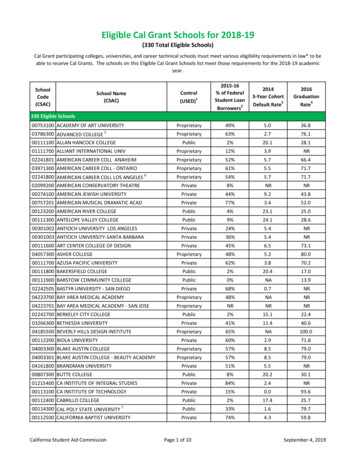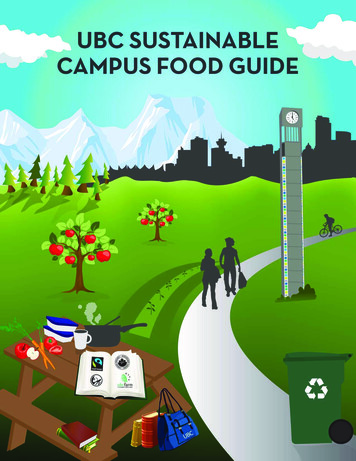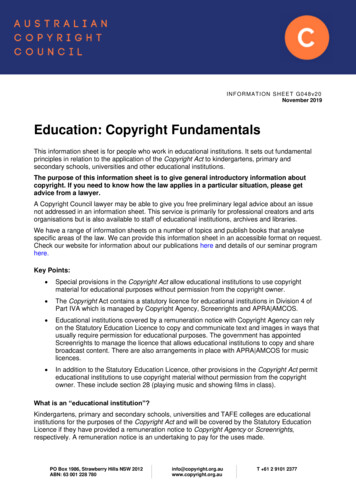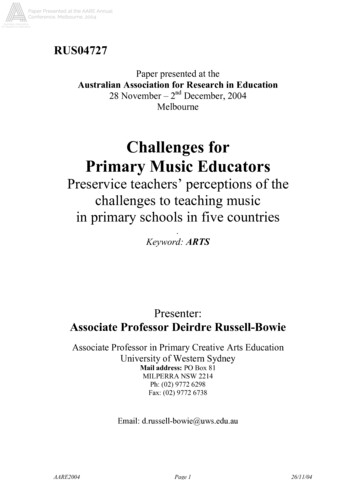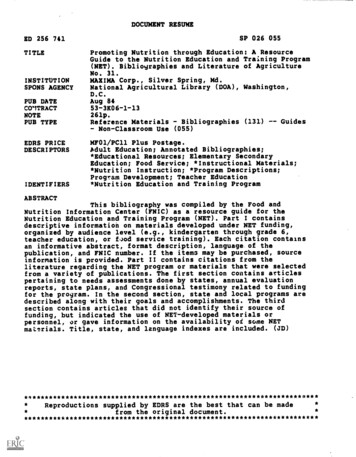
Transcription
Food teaching in primary schools:A framework of knowledge and skills
Food teaching in primary schools: A framework of knowledge and skillsAbout Public Health EnglandPublic Health England exists to protect and improve the nation's health and wellbeing,and reduce health inequalities. It does this through world-class science, knowledge andintelligence, advocacy, partnerships and the delivery of specialist public health services.PHE is an operationally autonomous executive agency of the Department of Health.Public Health EnglandWellington House133-155 Waterloo RoadLondon SE1 8UGTel: 020 7654 8000www.gov.uk/pheTwitter: @PHE ukFacebook: www.facebook.com/PublicHealthEnglandPrepared by: British Nutrition Foundation for Public Health England Crown copyright 2015You may re-use this information (excluding logos) free of charge in any format ormedium, under the terms of the Open Government Licence v3.0. To view this licence,visit OGL or email psi@nationalarchives.gsi.gov.uk. Where we have identified any thirdparty copyright information you will need to obtain permission from the copyrightholders concerned. Any enquiries regarding this publication should be sent toelizabeth.tydeman@phe.gov.ukPublished November 2015PHE publications gateway number: 20154622
Food teaching in primary schools: A framework of knowledge and skillsContentsIntroduction41. Developing professional competence62. Taking a whole school approach63. Teaching the curriculum64. Managing practical food classes75. Teaching food preparation and cooking (equipment, ingredients, food sources, functionalcharacteristics, processes and skills)86. Designing, making and evaluating food97. Promoting and applying nutrition98. Applying aspects of consumer awareness (food origin, food choice, food labelling) 109. Implementing good food safety and hygiene10Further information11Appendix 1: Needs analysis audit12Appendix 2: Skills153
Food teaching in primary schools: A framework of knowledge and skillsIntroductionThis framework is a guide to the knowledge and skills expected of primary schoolteachers who teach children about food. It outlines the knowledge and skills that wouldbe developed over time – resulting in exemplary food teaching.The aim is to help primary schools implement the requirements for food within the newNational Curriculum for Design and Technology (D&T) in England and the CoreCompetences for Children and Young People aged 5 to 16 years. These curriculummeasures, together with the other action points of the School Food Plan, seek topromote a 'pro-food' ethos in schools and heighten awareness of the integral part thatfood and a whole school approach plays in children's health, wellbeing and attainment.School food provision and how children keep themselves healthy will be monitored bythe Office for Standards in Education, Children’s Services and Skills (Ofsted) fromSeptember 2015 as part of the new Common Inspection Framework.The framework can be used to: review and plan courses for trainee teachers, and set out expectations forqualified teacher status audit current practice by existing teachers, supporting performance-relateddevelopment support professional reviews with colleagues plan and run professional training courses to support best practiceThe framework: sets standards, expectations and requirements for qualified teachers teachingfood in primary schools highlights key areas for development, presented in a manageable, easy toconvey way with clear expectations provides aspirational goals which will be developed over time (describingaccomplished food teaching) stipulates distinctive descriptions of food teaching, rather than generic teachingstandards (which they may be used alongside)The framework is presented in nine sections:1.2.3.4.5.Developing professional competenceTaking a whole school approachTeaching the curriculumManaging practical food classesTeaching food preparation and cooking4
Food teaching in primary schools: A framework of knowledge and skills6.7.8.9.Designing, making and evaluating foodPromoting and applying nutritionApplying aspects of consumer awarenessImplementing good food safety and hygieneThe stem for each section starts with ‘When teaching, accomplished teachers ’. Theterm ‘accomplished’ is used to describe a highly trained or skilled professional in aparticular activity.Acknowledgments:Public Health England (PHE), along with the British Nutrition Foundation (BNF),initiated the development of this framework in response to a meeting comprising theBNF, the Food Teachers Centre, Ofsted, the Department for Education and the SchoolFood Plan to discuss the management and provision of food teaching. All participantsfelt that guidelines would be of benefit to support teachers who deliver food teaching inschools.With thanks to:Alison Stafford, Healthy Schools LondonDaniel Walsh, The Campion SchoolDenise Maiden, Highworth Grammar SchoolElizabeth Tydeman, Public Health EnglandFrances Meek, British Nutrition FoundationHayley Wincott, Cromwell Community CollegeJane Sixthsmith, Focus on FoodJenny Elms, ConsultantKate Hufton, University of East LondonKate Morris, The Purple KitchenKim Down, British Nutrition FoundationLouis Levy, Public Health EnglandLouise T Davies, Food Teachers CentreRebecca Rylatt, Department for EducationRichard Green, Design and Technology AssociationRoy Ballam, British Nutrition FoundationSarah Grant, School Food PlanSarah Quick, West Exe SchoolSimon Gray, Food Teachers CentreSue Wood-Griffiths, Institute of Education, University of WorcesterZainab Ali, Department for Education5
Food teaching in primary schools1. Developing professional competenceWhen teaching, accomplished teachers:1.1 Further their professional expertise by selecting appropriate professionaldevelopment activities, such as observing experienced teachers, undertaking practicaltraining in food skills or updating their subject knowledge (through face-to-face eventsand online training);1.2 Develop an action plan for professional development (based on a needs analysisaudit) and how this will be applied in school;1.3 Ensure that they meet national standards for the subject, such as Level 2 FoodSafety.2. Taking a whole school approachWhen teaching, accomplished teachers:2.1 Contribute to whole school planning for food education. Work collaboratively withcolleagues to enhance learning opportunities, secure consistency of key concepts andhealthy eating messages (such as using the UK healthy eating model) and coherence(by sequencing when key concepts are taught across subjects, eg science, PSHE andphysical education);2.2 Use their expertise to support the whole school approach to food and thedevelopment of policies, understanding the position of food education in the health andwellbeing agenda of the whole school and work with school caterers where appropriate;2.3 Use their food lessons to motivate change in behaviour, such as to influence uptakeof healthier school lunch choices.3. Teaching the curriculumWhen teaching, accomplished teachers:3.1 Develop schemes of work that take account of current educational thinking, bestpractice, national policies and statutory requirements, for example, the nationalcurriculum programme of study, advice from professional associations (such as theDesign and Technology Association), School Food Plan, Ofsted guidance, Public HealthEngland and current healthy eating advice;6
Food teaching in primary schools: A framework of knowledge and skills3.2 Ensure that the range of food, ingredients and recipes studied come from the majorfood groups and reflect the recommended guidelines for a healthy diet;3.3 Set out a rationale for the scheme of work , including the aims, focus for eachschool year group, the anticipated starting point and differentiated learning outcomes forpupils, the key skills and knowledge that will be taught and the reason that these havebeen chosen. Review expectations against a nationally published progressionframework or similar;3.4 Communicate the aims and content of the scheme of work to a range of audiences,including parents/carers, other teachers and the pupils. Specify the key learning foreach activity in terms of skills and knowledge rather than recipe or project;3.5 Articulate and justify the resources that will be required to teach the curriculumeffectively and inclusively, such as budget for ingredients, equipment (including cookingfacilities), and learning support;3.6 Develop an effective support network to provide a rich learning experience forlearners, such as local food businesses, local chefs and food experts;3.7 Prepare or know where to access stimulating and up-to-date resources that supporteffective learning.4. Managing practical food classesWhen teaching, accomplished teachers:4.1 Set up safe food preparation and cooking space in the classroom, and know how toget pupils ready to cook;4.2 Select and demonstrate appropriate teaching strategies during different stages of apractical lesson, such as spot demonstrations, individual support, group discussionreview and tasting;4.3 Organise safe and successful tasting sessions;4.4 Use effective classroom systems for managing health and safety (such as cleaningand safe storage of ingredients and cooked dishes, allergens), resourcing practical work(such as shopping) and maintenance of equipment. Contribute to risk assessments;7
Food teaching in primary schools: A framework of knowledge and skills4.5 Act as role models of good practice for food storage, handling, preparing, cookingand serving food and drinks, including the safe use of equipment;4.6 Brief all those that work alongside them in the food classroom in the necessarysystems and processes, eg teaching assistants, parents and carers.5. Teaching food preparation and cooking (equipment,ingredients, food sources, functional characteristics,processes and skills)When teaching food, accomplished teachers understand how children learn keyconcepts and skills, and use age/ability appropriate teaching strategies that engagelearners, challenge a range of abilities, and build confidence and independence.When teaching, accomplished teachers:5.1 Name, taste and prepare a broad range of ingredients and healthy recipes,reflecting cultural diversity;5.2 Exhibit a high level of competence in a wide range of food skills and demonstratethese for effective learning (Appendix 2: Skills);5.3 Select and use an appropriate range of small equipment, safely and efficiently;5.4 Show awareness of their own safety and of those around them when handling foodand equipment. Ensure safe practices are always followed when using hot or sharpequipment, eg oven gloves;5.5 Choose ingredients, taking into account their nutritional, functional and sensoryproperties, in addition to other factors (such as cost, seasonality, sustainability);5.6 Apply skills and understanding to plan, prepare and cook simple dishes/menussafely and hygienically for a healthy, varied diet. Appreciate the value of eating together.8
Food teaching in primary schools: A framework of knowledge and skills6. Designing, making and evaluating foodWhen teaching food, accomplished teachers understand how children learn keyconcepts and skills, and use age/ability appropriate teaching strategies that engagelearners, challenge a range of abilities, and build confidence and independence.When teaching, accomplished teachers:6.1 Use research and develop criteria to inform the design of recipes, dishes and menusthat are fit for purpose, aimed at particular individuals or groups;6.2 Select from and use a wide range of ingredients, according to their functionalproperties and aesthetic qualities;6.3 Taste, evaluate and refine their ideas and dishes against a specification, takingaccount the views of others to improve their work;6.4 Investigate and analyse a range of existing food products.7. Promoting and applying nutritionWhen teaching food, accomplished teachers understand how children learn keyconcepts and skills, and use age/ability appropriate teaching strategies that engagelearners, challenge a range of abilities, and build confidence and independence.When teaching, accomplished teachers:7.1 Apply current healthy eating advice, and understanding of people’s needs, todeveloping diets for different individuals;7.2 Are aware of the importance of a healthy and balanced diet, good oral health andbeing physically active for health and wellbeing;7.3 Know that food and drinks provide energy in different amounts;7.4 Know that a variety of food is needed in the diet, and that these provide nutrients;7.5 Are aware that people’s food requirements change through life and that somepeople eat or avoid certain foods (religion/intolerance);9
Food teaching in primary schools: A framework of knowledge and skills7.6 Actively promote the benefits of a healthy diet and active lifestyle throughout theirteaching.8. Applying aspects of consumer awareness (food origin,food choice, food labelling)When teaching food, accomplished teachers understand how children learn keyconcepts and skills, and use age/ability appropriate teaching strategies that engagelearners, challenge a range of abilities, and build confidence and independence.When teaching, accomplished teachers:8.1 Understand where and how a variety of ingredients are grown, reared, caught andprocessed and know the basic steps in producing food;8.2 Recognise the wide range of factors involved in food and drink choice, includinginfluences such as preference, ethical belief, availability, season, need, cost, packaging,food provenance, culture, religion, allergy/intolerance, advertising, body image and peerpressure;8.3 Understand and demonstrate how to make informed choices to achieve a healthybalanced diet (such as utilising food labels and nutrition information);8.4 Are aware that it is important to choose appropriate portion sizes for their needs;8.5 Understand how the look, aroma and taste of food influences the choices thatpeople make. Use simple taste tests.9. Implementing good food safety and hygieneWhen teaching food, accomplished teachers understand how children learn keyconcepts and skills, and use age/ability appropriate teaching strategies that engagelearners, challenge a range of abilities, and build confidence and independence.When teaching, accomplished teachers:9.1 Understand the principles of cleaning, preventing cross contamination, chilling,cooking food thoroughly and reheating food until it is steaming hot;10
Food teaching in primary schools: A framework of knowledge and skills9.2 Apply food safety information on food labels when buying, storing and consumingfood and drinks;9.3 Know about food poisoning and its symptoms and undertake preventative measuresto reduce the risk of illness through bacterial contamination and multiplication;9.4 Are aware of common allergens and preventative measures to reduce the risk ofcontamination and allergic reaction;9.5 Understand the importance of good food safety and hygiene, including knowing howto get ready to cook (such as having hair tied back, removing jewellery and nail varnish,thoroughly washing and drying hands before and after handling food, and wearing aclean apron);9.6 Model exemplary practical skills and food safety and hygiene processes, includingpersonal hygiene.Further information British Nutrition Foundation: www.nutrition.org.ukChange4Life: e.aspxChildren’s Food Trust: http://www.childrensfoodtrust.org.uk/Core Competences for children and young people aged 5-16 mpetences/competences.htmlCountryside Classroom: http://www.countrysideclassroom.org.uk/Design and Technology Association: www.data.org.ukFACE: http://www.face-online.org.uk/Focus on Food: www.focusonfood.orgFood – a fact of life: http://www.foodafactoflife.org.uk/Food for Life partnership:http://www.foodforlife.org.uk/Food Standards Agency: www.food.gov.ukFood Teachers Centre: http://www.foodteacherscentre.co.uk/National Curriculum /national-curriculumNHS government/organisations/ofstedPublic Health s/public-health-englandxSchool Food Plan: http://www.schoolfoodplan.com/11
Food teaching in primary schools: A framework of knowledge and skillsAppendix 1: Needs analysis auditFor each section, reflect on each statement and rate your current competence. This will help todetermine your training needs.Name:Date:Developing .21.3Taking a whole school igh)2.12.22.3Teaching the curriculum3.13.23.33.43.53.63.7Managing practical food classes4.14.24.34.44.54.64.74.84.94.10Teaching food preparation andcooking5.15.25.35.45.55.612
Food teaching in primary schools: A framework of knowledge and skillsDesigning, making and gh)Promoting and applying nutrition12(Low)345Comments(High)Applying aspects of nts(High)Implementing good food safety h)7.17.27.37.47.57.6Actions Ggg Hhh Gg Jj Signed:13
Food teaching in primary schools: A framework of knowledge and skillsMY DEVELOPMENT RECORDNameAreas for developmentIdentification of specific professional(where you have gaps, least confidence, need development targetssupport or refresh)(to be addressed over the next phase oftraining)14
Food teaching in primary schools: A framework of knowledge and skillsAppendix 2: Skills15
Food teaching in primary schools: A framework of knowledge and skills16
Food teaching in primary schools: A framework of knowledge and skills17
5. Teaching food preparation and cooking (equipment, ingredients, food sources, functional characteristics, processes and skills) 8 6. Designing, making and evaluating food 9 7. Promoting and applying nutrition 9 8. Applying aspects of consumer awareness (food origin, food choice, food labelling) 10 9. Impl

